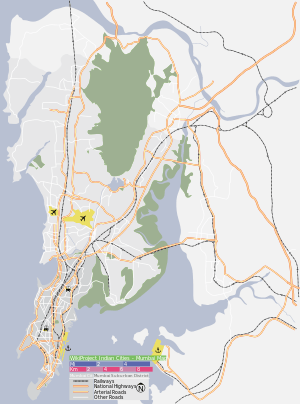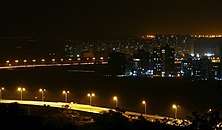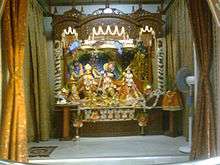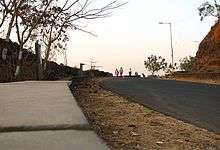Parsik Hill
Parsik Hill is a hill in the Mumbai Metropolitan Region, in Thane district of Maharashtra, India. It has a rail tunnel called Parsik tunnel. It is one of the longest and oldest tunnels in India and Asia.
| Parsik Hill | |
|---|---|
 Parsik Hill | |
| Geography | |
| Location | Maharashtra, India |
| Coordinates | 19°9′36.31″N 73°1′17.77″E |
| Elevation | 235 m. (1985) |
| Area | 15 square km. |
| Established | 1806 by queen victoria |
| Events | Railway tunnel and bollywood film shooting |
| Governing body | India Railway (IRCTC) |
History
Parsik Hill derives its name from the Parsi settlers who escaped from forced conversion to Christianity by the Portuguese. When Portuguese established their rule in Bassien (now Vasai), they asked the Parsi population to convert. Parsis asked them time to think it over thus buying time to escape to the hills near Kalyan, a jurisdiction outside the control of the Portuguese. Parsis only returned to Bassien after British established their rule.[1]
Geography
The hill has 10 feet (3.0 m) wide ridge that runs 7 kilometres (4.3 mi) north and south, paralleling the railway lines. The hill is approximately 15 square kilometres area of reserved forests, crossing into sections of both Thane and the north side of Navi Mumbai, where quarrying has removed the trees from the hill.[2][3] In 1985, the highest peak rose to 235 metres (771 ft).[4][5] Also on the top of hill stands the official residence of the Mayor of Navi Mumbai.[6]
Parsik's steep, scrub grassland hills have featured in some Bollywood movies.[3][7]
Ecological factors
Due to the impact of quarrying and illegal housing, there is concern about the extent to which the reserved forest will remain in years to come. An ecological activist comments: "The hill has a huge potential for eco-tourism, given that it runs through the municipal limits of Thane and Navi Mumbai and is about 30 minutes from Mumbai. Besides trekking trails, there is also a rock-climbing centre in Mumbra." The ecological balances is also being unsettled by the number of people building and living in shanties in the forest, which could result in reduction or disappearance of species of flora and fauna, including more than 100 bird species.[2]
Uses
Parsik Tunnel
The famous Parsik tunnel on Mumbai CST-Kalyan mainline lies in this hill. This tunnel is between Thane and Mumbra. Double Broad gauge track electrified passes through this tunnel. This reduced the distance between Thane and Diva to 7 km (4.3 mi) from formal 9.6 km (6.0 mi). This tunnel is 1.3 km (0.81 mi) in length. This tunnel is one of the oldest tunnel in Asia.
Recreational area
It has been a favorite area for hikers and, since the 1960s, for rock climbers.[2][7] Courses began to be conducted at Parsik Hills, having had a reputation as "some of the most interesting and convenient area for rock climbing", from the 1960s to 1980s by Darjeeling Sherpa instructors. One of the noted instructors was Nawang Gombu. Rock climbers can complete advanced climbs in one half to one day. The area, most enjoyable in the winter or monsoon season, must be accessed by cutting through groups of illegal shanties, or hutments, that occupy the hill.[8]
Quarrying
The area is losing its recreational appeal. About 9% of the top of the hill has been leveled due to quarrying, which is contracted to continue until about 2017. Material for general and road construction is created by blasting rock from the hill. It is estimated that at the present rate of excavation, 30% of the hill will have been removed or destroyed within that time.[2][9]
Illegal housing
Thousands of shanties, especially along Shil Phata Road, have been built to shelter otherwise homeless families; Forest officials were reported in 2012 to estimate 11,000 shelters were built in the forested land. About 100 unauthorized temples have also been built on the hill. Chief Conservator of the Forests, R K Pole, stated that there are periodic campaigns to remove the shanties in accordance with high court orders, but the net result is that there is little effort, whether through "lack of administrative will and indulgence from political parties", to properly protect the forest land. Deputy Conservator of the Forests, G T Chavan said that there were plans to better police and protect the land; "We will build a 50-km-long wall. We are working towards evicting the squatters."[2]
Gallery
 View of Navi Mumbai from Parsik Hill, including building on and beyond Palm Beach Road
View of Navi Mumbai from Parsik Hill, including building on and beyond Palm Beach Road Sri Sri Radha Madan Mohanji Ju at Gaudiya Vaishnava Association (GVA) Bhagavat Dham, Parsik Hill, CBD Belapur, Navi Mumbai
Sri Sri Radha Madan Mohanji Ju at Gaudiya Vaishnava Association (GVA) Bhagavat Dham, Parsik Hill, CBD Belapur, Navi Mumbai Parsik Hill walkway
Parsik Hill walkway
References
- "History of Parsik Hill".
- Clara Lewis, TNN (3 September 2012). "Encroachment, quarrying take a toll on Parsik Hill". Times of India. Retrieved 6 April 2013.
- Annapurna Shaw (2004). The Making of Navi Mumbai. Orient Blackswan. pp. 91, 116. ISBN 8125026002.
- Annapurna Shaw (2004). The Making of Navi Mumbai. Orient Blackswan. p. 92. ISBN 8125026002.
- Harish Kapadia (2004). Trek the Sahyadris (fifth edition). Indus Publishing. p. 51. ISBN 8173871515.
- "Bombay HC pulls up NMMC for acquiring 6 plots adjoining Mayor's residence". The Indian Express. 17 November 2016. Retrieved 28 November 2016.
- M.S. Kohli (2004). Mountains of India: Tourism, Adventure and Pilgrimage. Indus Publishing. p. 259. ISBN 8173871353.
- Harish Kapadia (2004). Trek the Sahyadris (fifth edition). Indus Publishing. pp. 15, 51. ISBN 8173871515.
- Annapurna Shaw (2004). The Making of Navi Mumbai. Orient Blackswan. p. 119. ISBN 8125026002.
Further reading
- Sunjoy Monga (2004). The Mumbai Nature Guide. India Book House.